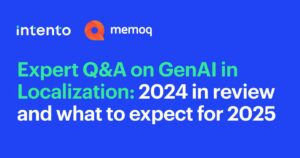If you’re running risk and compliance across borders, you’re living a daily paradox. Your risks are global, but your tools are often stubbornly monolingual. At the GRC Summit 2025, Grigory Sapunov, CTO and co-founder of Intento, laid out a future where this disconnect disappears – and it’s closer than you might think.
From human-centric to AI-centric translation
“For eight years, we’ve been providing enterprise-grade machine translation and AI translation solutions with our Enterprise Language Hub,” Grigory explained. “We focus on bringing translation to systems that employees use, such as MetricStream.”
The history of translation has followed a predictable arc – from entirely human-centered to increasingly machine-assisted. But something fundamental shifted in the last five years.
“We actually moved from human-enabled translation with technology to AI-centric translations when the results are reviewed and approved by humans,” Grigory noted. “So only human oversight.”
This isn’t just incremental improvement. It’s a paradigm shift that suddenly makes enterprise-wide multilingual operations practical at scale.
Enterprise translation requirements: Beyond the MT vs. LLM debate
The debate around translation technology often focuses on binary choices – traditional machine translation versus large language models. But Grigory quickly dismissed this framing.
“The reality is a bit different,” he explained. “From what we see from our clients, the most actionable and most successful use cases focus on using a combination of models together where each of them improves or fixes issues from other steps in the setup. For example, this might be a large language model improving translation output from a Machine Translation model, or even from a different large language model.”
Why this hybrid approach? Because traditional machine translation systems solve only a fraction of enterprise requirements:
- They’re good at producing fluent, grammatically correct text
- They handle high-frequency terms well (assuming they appear in training data)
- But they struggle with nearly everything else
The limitations become clear when Grigory displayed a comprehensive requirements framework:
- Do-not-translate terms are typically missed because MT systems learn from positive examples, not negative ones
- Context-dependent requirements (like formal vs. informal language) are ignored
- Consistency across documents breaks down because traditional MT works at the sentence level
- New or refined requirements require lengthy retraining cycles
“AI agents and LLMs are good at working with full text,” Grigory explained. “In this sense, consistency is much, much better.”
Why you can’t just prompt an LLM and hope
The obvious question: why not just throw all requirements into a prompt for a large language model and be done with it?
“The problem is typically it doesn’t work,” Grigory said. “There are many moving parts here. You need to adapt your LLM to particular tasks through prompting or fine-tuning, you may need retrieval augmented generation for external data, and you might want external tooling like calculators or domain-specific tools.”
Even cutting-edge models like GPT, Claude, and Gemini struggle with lengthy prompts. Grigory referenced fresh research showing performance degradation as prompt length increases, then mentioned Mistral AI’s just-released model with its 128K token context.
“Even with that, they deliberately say, ‘We do not guarantee it will work on the full prompt. We recommend limiting the prompt to 40K.’ It’s in the official documentation.”
The solution? An agentic approach with specialized AI components handling different aspects of the translation process.
“It enables very clear ownership and very easy change management,” Grigory explained. “If you have different requirements from marketing, finance, and some other places – even if you can technically put it in a single prompt, there’s still a problem of change management.”
The real cost of poor translation in GRC
This matters particularly for governance, risk, and compliance because of its inherently global nature.
“The majority of companies handle risk globally,” Grigory noted. “We work with large international companies with people in different countries. We ourselves have employees in more than 20 countries.”
This creates multiple translation imperatives:
- Risks, policies, and controls span countries with different regulations
- Multilingual reporting may be required by local authorities
- Giving teams access to content in their native language improves efficiency and reduces errors
“Providing multilingual access to globally distributed teams is not a nice-to-have,” Grigory emphasized. “It’s an operational necessity.”
The consequences of poor translation cascade across levels:
- Linguistic: Non-fluent text with mistakes
- Stylistic: Inappropriate tone or phrasing
- Regulatory: Incorrect references or factual inaccuracies
These lead to business risks:
- Misinterpretation of critical risk signals
- Inconsistencies in compliance across markets
- Incomplete audit trails
The agentic translation workflow in practice
What does this look like in practice? Grigory outlined a typical workflow that combines multiple AI agents:
- Translation Agent: Handles terminology, tone of voice, and fluency
- Corporate Style Agent: Adapts translations to company style guides
- Regulatory Agent: Checks translations against regulations to avoid factual errors
- In-Country Agent: Ensures that translations conform to local country rules and laws
“At the end, you can have quality translations – by quality translations, we mean translations that satisfy all of your requirements. In this sense, they’re indistinguishable from human translations.”
These agents don’t just translate – they can improve source content by fixing typos and slang, validate data against requirements, and adapt text to regulations even without translation.
The shift to multilingual GRC
We’re at an inflection point for multilingual GRC. The barriers that once made true global risk management impractical – cost, quality, and implementation complexity – are rapidly dissolving.
As one audience member put it after seeing the demo: “This has the potential to save us a lot of time.”
Time, certainly. But also risk exposure, compliance gaps, and operational friction. For organizations struggling to maintain consistent risk management across borders, the message was clear: the technology to unify global GRC operations through seamless translation is no longer theoretical – it’s here, it’s working, and it’s ready to deploy.



